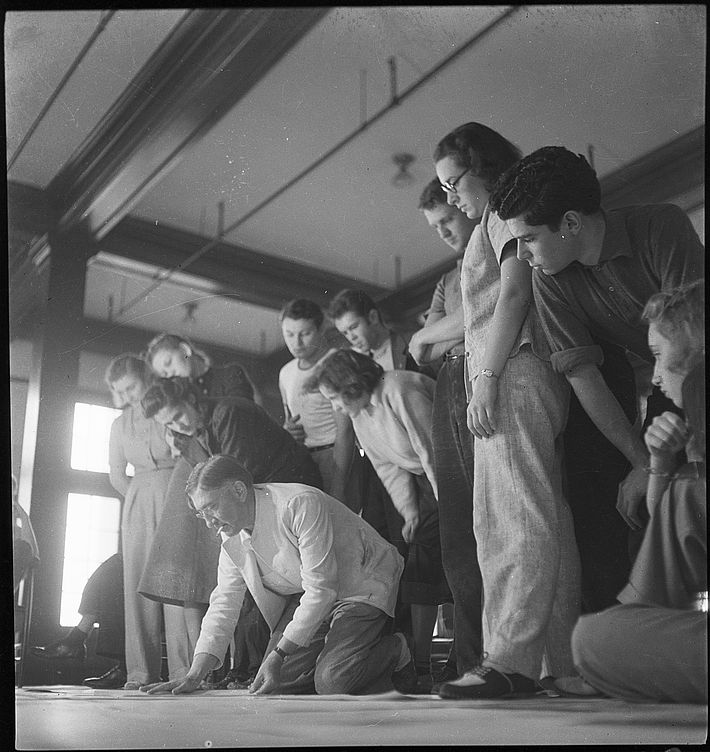The aftermath
from 1933
Teachers, students and networks carried Bauhaus ideas well beyond the places where the school operated and the years of its existence.

Headline
One of the distinctive features of the Bauhaus is that it integrated a diverse range of international trends and was required to reinvent itself in consistently new contexts due to its forced relocation. Perhaps the most intensive communication and propagation of the ideas coming from the Bauhaus occurred through the work of former teachers and students both in Germany and internationally and through the maintenance and establishment of new networks, even before its closure in 1933.

Europe
Gerhard Marcks, for example, went to the Burg Giebichenstein school of applied art in Halle in 1925. Oskar Schlemmer taught at the academy in Breslau from 1929 and Paul Klee at the art academy in Dusseldorf as of 1932. The Weimar architectural academy, the direct successor of the Bauhaus, employed former students and masters of the Bauhaus such as Ernst Neufert, Erich Dieckmann and Wilhelm Wagenfeld as teachers. In 1926, the former Bauhaus member Sándor Bortnyik founded the ‘Mühely’ (workshop) also known as the ‘Hungarian Bauhaus’.
The closure of the Bauhaus in 1933 was also followed by the incorporation of modern design and planning methods in the eclectic cultural concept of the National Socialists. Examples of this ‘Bauhaus modernism under National Socialism’ (Winfried Nerdinger) are found in the creative work of Herbert Bayer, Wilhelm Wagenfeld or Ernst Neufert.

USA
With the emigration of many members of the Bauhaus, the Bauhaus idea was transplanted into other cultural circles and under the new conditions, the contents and forms of expression changed. Josef and Anni Albers, Walter Gropius, Ludwig Mies van der Rohe, Marcel Breuer, Ludwig Hilberseimer, Walter Peterhans and Herbert Bayer emigrated to the USA. In 1937, the New Bauhaus was founded in Chicago by Lászlo Moholy-Nagy. Walter Gropius and above all Ludwig Mies van der Rohe became the most important and influential architects in the USA. Many ideas from America – Ford‘s rationalisation principles, the lifestyles associated with jazz, steel-frame constructions and the architecture of Frank Lloyd Wright – had already been influential at the Bauhaus and beyond in the 1920s, under the title of ‘Americanism’. In view of the reception of the Bauhaus in the USA, it is therefore possible to speak in terms of an extensive merging of existing concepts and patterns.
Sovjet Union
A far shorter and particularly tragic chapter in the activities of the Bauhaus is the fate of Hannes Meyer and a group of his students in the Soviet Union, particularly during the period from 1930 to 1937. They had hoped to contribute to the development of a socialist society and worked on urban planning and architectural assignments until the start of the Stalinist Terror of the mid-1930s. After 1932, many members of the building brigades that remained in the USSR sacrificed the concept of modernity in favour of socialist classicism; some were murdered or sent to the Gulag prison camps.
Elsewhere
In the Eastern Mediterranean countries, a fusion of Northern European ideas (of which some of the most essential came from the Bauhaus) with Mediterranean forms (Arieh Sharon in places such as Israel) occurred from the 1920s in the course of modernisation (Turkey under Atatürk) and the settlement movement (Palestine). A specific reception of the Bauhaus, which however rarely had an impact on architecture and design plans, appears in places like Japan (through Japanese Bauhaus students) and Mexico (the exile of Hannes Meyer in the 1940s).

HfG Ulm
The former Bauhaus masters and students played a major role in both German states after 1945. In the Federal Republic of Germany, the Academy of Design (HfG) in Ulm, which began its work in 1953 and existed until 1968 (Max Bill and others) provides an outstanding example alongside the work of Otto Lindig, Gerhard Marcks, Kurt Kranz and Hannes Neuner at applied art schools and other schools.

GDR
The post-war period also initially made it possible to build on the Bauhaus concepts in the late GDR-era, even at the architecture and design academies where former Bauhaus members had influential positions. Following the debate on formalism that was directed against the Bauhaus from 1950, the Bauhaus once again became an important point of reference in the late-1960s. Among others, the Bauhaus members Peter Keler, Marianne Brandt, Richard Paulick, Hajo Rose and Walter Funkat lived and worked in the GDR.